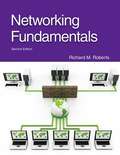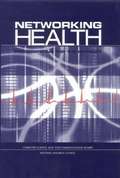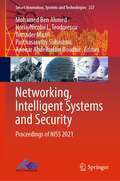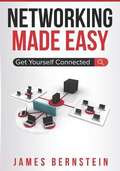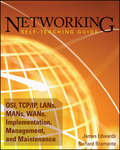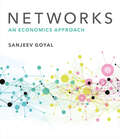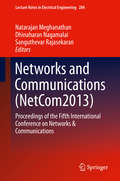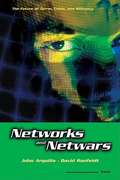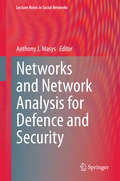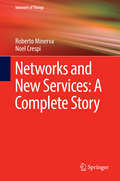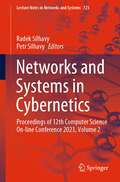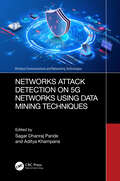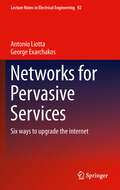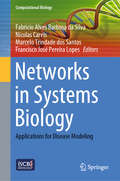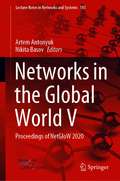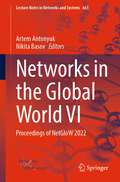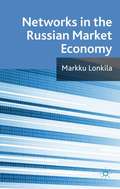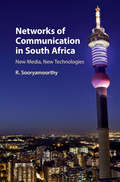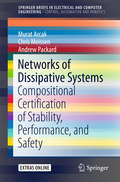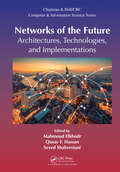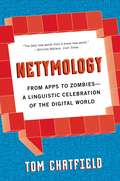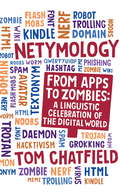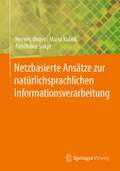- Table View
- List View
Networking Health: Prescriptions for the Internet
by National Research CouncilConsumer health websites have garnered considerable media attention, but only begin to scratch the surface of the more pervasive transformations the Internet could bring to health and health care. Networking Health examines ways in which the Internet may become a routine part of health care delivery and payment, public health, health education, and biomedical research. Building upon a series of site visits, this book: Weighs the role of the Internet versus private networks in uses ranging from the transfer of medical images to providing video-based medical consultations at a distance.Reviews technical challenges in the areas of quality of service, security, reliability, and access, and looks at the potential utility of the next generation of online technologies.Discusses ways health care organizations can use the Internet to support their strategic interests and explores barriers to a broader deployment of the Internet.Recommends steps that private and public sector entities can take to enhance the capabilities of the Internet for health purposes and to prepare health care organizations to adopt new Internet-based applications.
Networking, Intelligent Systems and Security: Proceedings of NISS 2021 (Smart Innovation, Systems and Technologies #237)
by Mohamed Ben Ahmed Horia-Nicolai L. Teodorescu Tomader Mazri Parthasarathy Subashini Anouar Abdelhakim BoudhirThis book gathers best selected research papers presented at the International Conference on Networking, Intelligent Systems and Security, held in Kenitra, Morocco, during 01–02 April 2021. The book highlights latest research and findings in the field of ICT, and it provides new solutions, efficient tools, and techniques that draw on modern technologies to increase urban services. In addition, it provides a critical overview of the status quo, shares new propositions, and outlines future perspectives in networks, smart systems, security, information technologies, and computer science.
Networking Made Easy: Get Yourself Connected (Computers Made Easy)
by James BernsteinNetworking Made Easy is designed to take your overall networking skills from a beginner to the next level. Get a top-level understanding without a complex education. This easy to use guide will help you navigate your way to becoming proficient with network fundamentals and technology.
Networking Self-Teaching Guide
by James Edwards Richard BramanteIT professionals who want to move into the networking side in a corporate or enterprise setting will find the detailed content they need to get up to speed on the very latest networking technologies; plus, current networking professionals will find this a valuable and up-to-date resource. This hands-on guide is designed so that you can select, design, and implement an actual network using the tutorials and steps in the book. Coverage includes an overview of networking technologies, including the hardware, software, transmission media, and data transfer processes; in-depth coverage of OSI and TCP/IP reference models; operating systems and other systems software used in today?s networks; LANs, WANS, and MANs, including the components and standards that operate within each type of area network; and more.
Networks: An Economics Approach
by Sanjeev GoyalAn accessible and comprehensive overview of the economic theory and the realities of networks written by a pioneering economics researcher.Networks are everywhere: the infrastructure that brings water into our homes, the social networks made up of our friends and families, the supply chains connecting cities, people, and goods. These interconnections contain economic trade-offs: for example, should an airline operate direct flights between cities or route all its flights through a hub? Viewing networks through an economics lens, this textbook considers the costs and benefits that govern their formation and functioning. Networks are central to an understanding of the production, consumption, and information that lie at the heart of economic activity. Sanjeev Goyal provides advanced undergraduate and graduate students with an accessible and comprehensive introduction to the economics research on networks of the past twenty-five years. Each chapter introduces a theoretical model illustrated with the help of case studies and formal proofs. After introducing the theoretical concepts, Goyal examines economic networks, including infrastructure, security, market power, and financial networks. He then covers social networks, with chapters on coordinating activity, communication and learning, information networks, epidemics, and impersonal markets. Finally, Goyal locates social and economic networks in a broader context covering networked markets, economic development, trust, and group networks in their relation to markets and the state.First textbook to provide a broad and comprehensive overview of twenty-first-century economic theory of networks Features engaging case studies and accessible exercisesWritten by a pioneering economics researcher
Networks and Communications (NetCom2013)
by Natarajan Meghanathan Dhinaharan Nagamalai Sanguthevar RajasekaranThis book covers theory, methodology and applications of computer networks, network protocols and wireless networks, data communication technologies, and network security. The book is based on the proceedings from the Fifth International Conference on Networks & Communications (NetCom). The proceedings will feature peer-reviewed papers that illustrate research results, projects, surveys and industrial experiences that describe significant advances in the diverse areas of computer networks & communications.
Networks and Netwars
by David Ronfeldt John ArquillaNetwar-like cyberwar-describes a new spectrum of conflict that is emerging in the wake of the information revolution. Netwar includes conflicts waged, on the one hand, by terrorists, criminals, gangs, and ethnic extremists; and by civil-society activists (such as cyber activists or WTO protestors) on the other. What distinguishes netwar is the networked organizational structure of its practitioners-with many groups actually being leaderless-and their quickness in coming together in swarming attacks. To confront this new type of conflict, it is crucial for governments, military, and law enforcement to begin networking themselves.
Networks and Network Analysis for Defence and Security
by Anthony J. MasysNetworks and Network Analysis for Defence and Security discusses relevant theoretical frameworks and applications of network analysis in support of the defence and security domains. This book details real world applications of network analysis to support defence and security. Shocks to regional, national and global systems stemming from natural hazards, acts of armed violence, terrorism and serious and organized crime have significant defence and security implications. Today, nations face an uncertain and complex security landscape in which threats impact/target the physical, social, economic and cyber domains. Threats to national security, such as that against critical infrastructures not only stem from man-made acts but also from natural hazards. Katrina (2005), Fukushima (2011) and Hurricane Sandy (2012) are examples highlighting the vulnerability of critical infrastructures to natural hazards and the crippling effect they have on the social and economic well-being of a community and a nation. With this dynamic and complex threat landscape, network analysis has emerged as a key enabler in supporting defence and security. With the advent of 'big data' and increasing processing power, network analysis can reveal insights with regards to structural and dynamic properties thereby facilitating greater understanding of complex networks, their entities, interdependencies, vulnerabilities to produce insights for creative solutions. This book will be well positioned to inform defence, security and intelligence professionals and researchers with regards to leading methodologies and approaches.
Networks and New Services: A Complete Story
by Roberto Minerva Noel CrespiThis book shines a spotlight on software-centric networks and their emerging service environments. The authors examine the road ahead for connectivity, for both humans and 'things', considering the rapid changes that have shaken the industry. The book analyses major catalytic shifts that are shaping the communications world: softwarization, virtualization, and cloud computing. It guides the reader through a maze of possible architectural choices, driven by discriminating and sometimes conflicting business considerations. The new ICT capabilities lead us toward smarter environments and to an ecosystem where applications are backed up by shared networking facilities, instead of networks that support their own applications. Growing user awareness is a key driver towards the softwarization process. Softwarization disrupts the current status quo for equipment, development, networks, operations and business. It changes radically the value chain and the involved stakeholders. The dilemma is between a 'slow burn' traditional step-by-step approach and a bold transformation of the whole infrastructure and business models. This book is essential reading for those seeking to build user-centric communication networks that support independent agile and smart applications. "The book gives an insightful account of modern telecom networks, pinpointing the radical transformations of the last 20 years. This is the perfect read for those who are interested in the grand challenges of networks and in the socio-economic reasons why the telecom industry to embrace the Internet of Things and cyber-physical systems. " Prof. Antonio Liotta, Eindhoven University of Technology "This book fulfills an urgent need to thoroughly analyze the entanglement of network and software architectures by taking into account the increasing softwarization. It highlights important issues behind today's business models and opens the road for sustainable future approaches to provide user appreciated valuable services. " Dr. Eng. Hendrik Berndt, former CTO of NTT DOCOMO Communications Laboratories Europe
Networks and Systems in Cybernetics: Proceedings of 12th Computer Science On-line Conference 2023, Volume 2 (Lecture Notes in Networks and Systems #723)
by Radek Silhavy Petr SilhavyThe Networks and Systems in Cybernetics section continues to be a highly relevant and rapidly evolving area of research, encompassing modern advancements in informatics and cybernetics within network and system contexts. This field is at the forefront of developing cutting-edge technologies that can tackle complex challenges and improve various aspects of our lives. The latest research in this field is featured in this book, which provides a comprehensive overview of recent methods, algorithms, and designs. The book comprises the refereed proceedings of the Cybernetics Perspectives in Systems session of the 12th Computer Science Online Conference 2023 (CSOC 2023), which was held online in April 2023. The book offers a unique opportunity to explore the latest advances in cybernetics and informatics and their applications in a range of domains. It brings together experts from various disciplines to share their insights and collaborate on research that can shape the future of our world. One of the key themes of this section is the application of cybernetics in intelligent systems. This area has significant potential to revolutionize a range of industries. Researchers are exploring how cybernetic principles can be used to create intelligent systems that can learn, adapt, and optimize their performance over time.
Networks Attack Detection on 5G Networks using Data Mining Techniques (Wireless Communications and Networking Technologies)
by Sagar Dhanraj Pande Aditya KhampariaArtificial intelligence (AI) and its applications have risen to prominence as one of the most active study areas in recent years. In recent years, a rising number of AI applications have been applied in a variety of areas. Agriculture, transportation, medicine, and health are all being transformed by AI technology. The Internet of Things (IoT) market is thriving, having a significant impact on a wide variety of industries and applications, including e-health care, smart cities, smart transportation, and industrial engineering. Recent breakthroughs in artificial intelligence and machine learning techniques have reshaped various aspects of artificial vision, considerably improving the state of the art for artificial vision systems across a broad range of high-level tasks. As a result, several innovations and studies are being conducted to improve the performance and productivity of IoT devices across multiple industries using machine learning and artificial intelligence. Security is a primary consideration when analyzing the next generation communication network due to the rapid advancement of technology. Additionally, data analytics, deep intelligence, deep learning, cloud computing, and intelligent solutions are being employed in medical, agricultural, industrial, and health care systems that are based on the Internet of Things. This book will look at cutting-edge Network Attacks and Security solutions that employ intelligent data processing and Machine Learning (ML) methods.This book: Covers emerging technologies of network attacks and management aspects. Presents artificial intelligence techniques for networks and resource optimization, and toward network automation, and security. Showcases recent industrial and technological aspects of next-generation networks Illustrates artificial intelligence techniques to mitigate cyber-attacks, authentication, and authorization challenges. Explains smart, and real-time monitoring services, multimedia, cloud computing, and information processing methodologies in 5G networks. It is primarily for senior undergraduates, graduate students and academic researchers in the fields of electrical engineering, electronics and communication engineering, computer engineering, and information technology.
Networks, Crowds, and Markets
by David Easley Jon KleinbergAre all film stars linked to Kevin Bacon? Why do the stock markets rise and fall sharply on the strength of a vague rumour? How does gossip spread so quickly? Are we all related through six degrees of separation? There is a growing awareness of the complex networks that pervade modern society. We see them in the rapid growth of the Internet, the ease of global communication, the swift spread of news and information, and in the way epidemics and financial crises develop with startling speed and intensity. This introductory book on the new science of networks takes an interdisciplinary approach, using economics, sociology, computing, information science and applied mathematics to address fundamental questions about the links that connect us, and the ways that our decisions can have consequences for others.
Networks for Pervasive Services
by Antonio Liotta George ExarchakosReaders will progress from an understanding of what the Internet is now towards an understanding of the motivations and techniques that will drive its future.
Networks in Systems Biology: Applications for Disease Modeling (Computational Biology #32)
by Fabricio Alves Barbosa da Silva Nicolas Carels Marcelo Trindade dos Santos Francisco José Pereira LopesThis book presents a range of current research topics in biological network modeling, as well as its application in studies on human hosts, pathogens, and diseases. Systems biology is a rapidly expanding field that involves the study of biological systems through the mathematical modeling and analysis of large volumes of biological data. Gathering contributions from renowned experts in the field, some of the topics discussed in depth here include networks in systems biology, the computational modeling of multidrug-resistant bacteria, and systems biology of cancer. Given its scope, the book is intended for researchers, advanced students, and practitioners of systems biology. The chapters are research-oriented, and present some of the latest findings on their respective topics.
Networks in the Global World V: Proceedings of NetGloW 2020 (Lecture Notes in Networks and Systems #181)
by Artem Antonyuk Nikita BasovThis proceedings book presents state-of-the-art developments in theory, methodology, and applications of network analysis across sociology, computational science, education research, literature studies, political science, international relations, social media research, and urban studies. The papers comprising this collection were presented at the Fifth ‘Networks in the Global World’ conference organized by the Centre for German and European Studies of St. Petersburg University and Bielefeld University and held on July 7–9, 2020. This biannual conference series revolves around key interdisciplinary issues in the focus of network analysts, such as the multidimensional approach to social reality, translation of theories and methods across disciplines, and mixing of data and methods. The distinctive features of this book are the emphasis on in-depth linkages between theory, method, and applications, the blend of qualitative and quantitative methods, and the joint consideration of different network levels, types, and contexts. The topics covered by the papers include interrelation of social and cultural structures, constellations of power, and patterns of interaction in areas ranging from various types of communities (local, international, educational, political, and so on) to social media and literature. The book is useful for practicing researchers, graduate and postgraduate students, and educators interested in network analysis of social relations, politics, economy, and culture. Features that set the book apart from others in the field: · The book offers a unique cross-disciplinary blend of computational and ethnographic network analyses applied to a diverse spectrum of spheres, from literature and education to urban planning and policymaking. · Embracing conceptual, methodological, and empirical works, the book is among the few in network analysis to emphasize connections between theory, method, and applications. · The book brings together authors and empirical contexts from all over the globe, with a particular emphasis on European societies.
Networks in the Global World VI: Proceedings of NetGloW 2022 (Lecture Notes in Networks and Systems #663)
by Artem Antonyuk Nikita BasovThis book covers relations between social and cultural structures, power, and interaction in communities, social media, and literature. The areas range from politics and urban planning to literature and education. The collected chapters were presented at the Sixth ‘Networks in the Global World’ conference held on June 22–24, 2022. This biannual conference series revolves around key interdisciplinary issues in the focus of network analysts, such as the multidimensional approach to social reality, translation of theories and methods across disciplines, and mixing of data and methods. The topics covered by the chapters cover relations between social and cultural structures, power, and interaction in communities, social media, and literature. The book is useful for practicing researchers, graduate and post-graduate students, and educators interested in social relations, politics, economy, and culture.
Networks in the Russian Market Economy
by Markku LonkilaA PDF version of this book is available for free in open access via the OAPEN Library platform, www. oapen. org. This book examines the significance of networks among the firms operative in the contemporary Russian software industry in the St. Petersburg region.
Networks of Communication in South Africa: New Media, New Technologies
by R. SooryamoorthyWithin a short period of time, South Africa has made remarkable progress in the adoption of mobile and Internet technologies. In this landmark study, R. Sooryamoorthy examines the development of communication patterns, social contacts and networks in South Africa. Based on pioneering quantitative and qualitative data, he analyses trends in changing media use in Africa, showing the development of the use of new media for communication by South Africans of all ages, races and genders in relation to the development of media infrastructure, its cost and government policy. It shows how people use the media for communication purposes that affirm or break their social contacts and networks, and how they apply media to establish, re-establish or maintain social relationships. This book will be of interest to those researching the growth of communication technology in Africa, as well as those involved in the wider fields of development studies and economics.
Networks of Dissipative Systems
by Murat Arcak Chris Meissen Andrew PackardThis book addresses a major problem for today's large-scale networked systems: certification of the required stability and performance properties using analytical and computational models. On the basis of illustrative case studies, it demonstrates the applicability of theoretical methods to biological networks, vehicle fleets, and Internet congestion control. Rather than tackle the network as a whole --an approach that severely limits the ability of existing methods to cope with large numbers of physical components-- the book develops a compositional approach that derives network-level guarantees from key structural properties of the components and their interactions--the book addresses this problem by pursuing a compositional approach that derives network-level guarantees from key structural properties of the subsystems and their interactions. The foundational tool in this approach is the established dissipativity theory, which is reviewed in the first chapter and supplemented with modern computational techniques. The book blends this theory with the authors' recent research efforts at a level that is accessible to graduate students and practising engineers familiar with only the most basic nonlinear systems concepts. Code associated with the numerical examples can be downloaded at extras. springer. com, allowing readers to reproduce the examples and become acquainted with the relevant software.
Networks of the Future: Architectures, Technologies, and Implementations (Chapman & Hall/CRC Computer and Information Science Series)
by Seyed Shahrestani Qusay F. Hassan Mahmoud ElkhodrWith the ubiquitous diffusion of the IoT, Cloud Computing, 5G and other evolved wireless technologies into our daily lives, the world will see the Internet of the future expand ever more quickly. Driving the progress of communications and connectivity are mobile and wireless technologies, including traditional WLANs technologies and low, ultra-power, short and long-range technologies. These technologies facilitate the communication among the growing number of connected devices, leading to the generation of huge volumes of data. Processing and analysis of such "big data" brings about many opportunities, as well as many challenges, such as those relating to efficient power consumptions, security, privacy, management, and quality of service. This book is about the technologies, opportunities and challenges that can drive and shape the networks of the future. Written by established international researchers and experts, Networks of the Future answers fundamental and pressing research challenges in the field, including architectural shifts, concepts, mitigation solutions and techniques, and key technologies in the areas of networking. The book starts with a discussion on Cognitive Radio (CR) technologies as promising solutions for improving spectrum utilization, and also highlights the advances in CR spectrum sensing techniques and resource management methods. The second part of the book presents the latest developments and research in the areas of 5G technologies and Software Defined Networks (SDN). Solutions to the most pressing challenges facing the adoption of 5G technologies are also covered, and the new paradigm known as Fog Computing is examined in the context of 5G networks. The focus next shifts to efficient solutions for future heterogeneous networks. It consists of a collection of chapters that discuss self-healing solutions, dealing with Network Virtualization, QoS in heterogeneous networks, and energy efficient techniques for Passive Optical Networks and Wireless Sensor Networks. Finally, the areas of IoT and Big Data are discussed, including the latest developments and future perspectives of Big Data and the IoT paradigms.
Netymology: A Linguistic Celebration of the Digital World
by Tom ChatfieldComposed of 100 bite-sized entries of 400 to 600 words each, Netymology weaves together stories, etymologies and analyses around digital culture's transformation and vocabulary. Chatfield presents a kaleidoscopic, thought-provoking tour through the buried roots of the symbols, speech, and mannerisms we have inherited from the digital age: from the @ and Apple symbols, to HTML and Trojan horses, to the twisted histories of new forms of slang, memes, text messages and gaming terms; how language itself is being shaped by technology, how it is changing us.
Netymology: From Apps to Zombies: A Linguistic Celebration of the Digital World
by Tom ChatfieldComposed of 100 bite-sized entries of 400 to 600 words each, Netymology weaves together stories, etymologies and analyses around digital culture's transformation, and creation, of words. Tom Chatfield presents a kaleidoscopic, thought-provoking tour through the buried roots of some of the digital age's most common terms: from the @ and Apple symbols, to HTML and Trojan horses, to the twisted histories of new forms of slang, memes, text messages and gaming terms. There's also discussion of the trends behind digital words, and of the ways language itself is being shaped by new forces - and revelations about how these forces are, in turn, reshaping us.
Netymology: From Apps to Zombies: A Linguistic Celebration of the Digital World
by Tom ChatfieldComposed of 100 bite-sized entries of 400 to 600 words each, Netymology weaves together stories, etymologies and analyses around digital culture's transformation, and creation, of words. Tom Chatfield presents a kaleidoscopic, thought-provoking tour through the buried roots of some of the digital age's most common terms: from the @ and Apple symbols, to HTML and Trojan horses, to the twisted histories of new forms of slang, memes, text messages and gaming terms. There's also discussion of the trends behind digital words, and of the ways language itself is being shaped by new forces - and revelations about how these forces are, in turn, reshaping us.
Netzbasierte Ansätze zur natürlichsprachlichen Informationsverarbeitung
by Herwig Unger Mario Kubek Panchalee SukjitFür Leser, die bereits die Grundlagen der Wissensverarbeitung und Computernetzwerke beherrschen, gibt das Buch einen Überblick über innovative Verfahren, die die automatisierte Suche, Recherche, Klassifikation und Verwaltung von Texten im Kontext dezentraler Systeme und vor allem im WWW erlauben. Besondere Aufmerksamkeit wird dabei auf eine personalisierte Verarbeitung gerichtet, die auch zeitliche Aspekte, wie z. B. das digitale Vergessen, einbeziehen. An vielen Stellen werden auf interessante und neuartige Art und Weise Analogien aus anderen Wissensgebieten, so z. B. zur Verarbeitung von Informationen und zum Lernen im menschlichen Gehirn sowie der Natur schlechthin genutzt.
